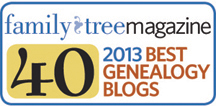NERGC 2013 – Day 3
Yesterday was the last day for me at the New England Regional Genealogy Conference (NERGC) for 2013. Over the past three days I’ve attended met up with and spent some times with friends I haven’t seen in a while, attended a lot of lectures, met a lot of great people and a whole lot more. I’m already looking forward to NERGC 2015 which is being planned and will be held in Providence, Rhode Island.
The first lecture of the day I went to was by David Ouimette. I had heard one of his lectures already so I was very excited about hearing him talk again and I was not disappointed. His lecture was about “But She Died in Upstate New York in the 1850s: How can I Identify Her Parents?”. If you have any ancestors in upstate New York at that time, like myself, you know how difficult it can be. There are no vital records for the time period and other available records seem to be pretty scarce. Using indirect records from New York and some direct records of neighboring areas, including Vermont and Canada, he was able to determine who the parents were in this case study.
The second lecture of the day I went to was entitled “Bittner Bastards of Bavaria” and was given by F. Warren Bittner. It was supposed to have been a lecture on “Documents to Narrative: Writing to Engage your Reader. I was really looking forward to the lecture about writing, but the Power Point had gotten corrupted and Warren needed to make the change at the last minute. Even though I was a little disappointed about not getting to hear the lecture about writing, Warren is a very entertaining speaker and he mixed in some writing topics along the way of telling the case story about his ancestors in Bavaria.
The last lecture I attended for the day was “Demystifying Digitizing: Scanning and Photographing for Family History”. It was given by Kathy Bolduc Amoroso of the Main Historical Society. The Maine Memory Network is going through a series of scanning projects to digitize a lot of Maine’s historical documents. Instead of scanning a document at a particular DPI, they have scanned documents so that they can reproduce an image on 11″ by 14″. This seems to have come out to about 40mb per image when utilizing a tiff format. She recommends saving the original scan in a tiff format as well as the lessor quality jpeg format.
There were two more slots of lectures which were available, but I decided to get an early start on the 3.5 hour ride home. The ride home was uneventful and even though I had a lot of fun, I was looking forward to getting home and relaxing.

